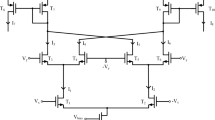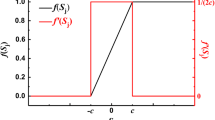Abstract
The demands on offsets in analog weight adaptation circuitry are very high for onchip learning feed-forward neural networks using a back-propagation type of learning rule. Exceeding of the specifications for weight adaptation offsets prevents the weights from converging to their optimum, which leads to a significantly degraded learning behavior. This letter presents a circuit, including a tuning system, that minimizes weight adaptation offsets and that can be used to implement analog on-chip back-propagation learning feed-forward neural networks.
Similar content being viewed by others
Explore related subjects
Discover the latest articles, news and stories from top researchers in related subjects.References
D.E. Rumelhart, G.E. Hinton, R.J. Williams. Learning internal representations by error propagation, in D.E. Rumelhart and J.L. McClelland eds.,Parallel Distributed Processing, vol. 1, ch. 8, Cambridge MA: MIT Press, 1986.
K. Asanovic, N. Morgan. Experimental determination of precision requirements for backpropagation training of artificial neural networks, inProc. of the 2nd Int'l. Conference on MicroNeuro, Munich, Kyrill&Method Verlag, pp. 9–16, 1991.
Y. Xie, M.A. Jabri. Analysis of effects ofquantization in multilayer neural networks using statistical model,Electronics Letters, vol. 27, pp. 1196–1198, 1991.
A.F. Murray, P.J.Edwards. Synaptic weight noise during multilayer perceptron training: fault tolerance and training improvements,IEEE Trans. on Neural Networks, pp. 722–725, 1993.
A.J. Annema, K. Hoen, H.Wallinga. Precision requirements for single-layer feed-forward neural networks, inProc. fourth Int'l. Conference on MicroNeuro, Turin, pp. 145–151, 1994.
R. Wijburg.UT-BICMOS Design Manual, internal report, University of Twente, 1991
C. Eichenberger, W. Guggenbuhl. On charge injection in analog MOS switches and dummy switch compensation techniques,IEEE Trans. on Circuits and Systems, vol. 37, no. 2, pp. 256–264, 1990.
S. Espejo, A. Rodriguez-Vazquez, R. Dominguez-Castro, J.L. Huertas. A modified dummy-switch technique for tunable feedthrough cancellation in switched-current circuits,Proc. of ESSCIRC 1993, pp. 270–273, 1993.
D.B. Mundie, L.W. Massengill. Weight decay and resolution effects in feedforward artificial neural networks,IEEE Trans. on Neural Networks, pp. 168–170, 1991.
Author information
Authors and Affiliations
Rights and permissions
About this article
Cite this article
Annema, A.J., Wallinga, H. Analog weight adaptation hardware. Neural Process Lett 2, 7–11 (1995). https://doi.org/10.1007/BF02311572
Issue Date:
DOI: https://doi.org/10.1007/BF02311572




